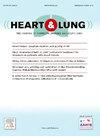成人慢性躯体疾病的症状感知:对岛岛损伤的系统回顾。
IF 2.4
4区 医学
Q2 CARDIAC & CARDIOVASCULAR SYSTEMS
引用次数: 0
摘要
背景:为了进行自我护理,慢性疾病患者必须能够感知身体的变化。(内感受)这样他们就能在症状出现时做出反应内感受是由大脑的岛叶皮质调节的。多种躯体疾病的症状感知能力较差,可能与岛叶皮层的损伤有关。目的:探讨成人慢性躯体疾病患者是否存在胰岛损伤模式,并分析其与疾病相关症状的关系。方法:我们通过搜索5个数据库,确定了通过MRI和/或(f)MRI评估成人慢性躯体疾病患者(与健康对照)脑岛结构和/或活动的研究。结果作为叙述综合报告。结果:50项研究对糖尿病、癌症、心力衰竭或慢性肺病患者的脑岛结构或活动进行了调查。在19项研究中,研究人员发现慢性疾病患者的胰岛体积/密度/厚度比健康对照者更低/受损,或胰岛血流量减少。当在22项研究中探索岛岛活动时,大多数研究人员报告岛岛活动较高,神经连通性较低。五项研究探讨了岛屿体积/活动与症状严重程度之间的关系:四项研究报告了积极的趋势。结论:慢性躯体疾病患者的脑岛灰质体积/密度/厚度均低于健康人,且脑岛活动异常。胰岛活动可能与症状严重程度有关。这些结果表明,岛的结构和/或活动可能解释了不良的症状感知。本文章由计算机程序翻译,如有差异,请以英文原文为准。
Symptom perception in adults with chronic physical disease: A systematic review of insular impairments
Background
To perform self-care, individuals with a chronic illness must be able to perceive bodily changes (ie., interoception) so they can respond to symptoms when they arise. Interoception is regulated by the insular cortex of the brain. Symptom perception is poor in various physical diseases, which may be associated with impairments in the insular cortex.
Objective
The purpose of this study was to explore whether patterns of insular impairment exist among adults with chronic physical diseases and to analyze the relationship with disease-related symptoms.
Methods
We identified studies that assessed the structure and/or activity of the insula through MRI and/or (f)MRI in adults with chronic physical diseases (vs. healthy controls) by searching five databases. Results are reported as a narrative synthesis.
Results
Fifty studies were conducted to investigate the structure or activity of the insula among adults with diabetes, cancer, heart failure, or chronic pulmonary disease. In 19 studies investigators found that patients with a chronic disease had lower/damaged insular volume/density/thickness than healthy controls or reduced insular blood flow. When insular activity was explored in 22 studies, most investigators reported higher insular activity and lower neural connectivity. Five studies explored the association between insular volume/activity and symptom severity: four reported a positive trend.
Conclusion
People with chronic physical diseases have lower insular grey matter volume/density/thickness and abnormal insular activity when compared to healthy people. Insular activity may be related to symptom severity. These results suggest that insular structure and/or activity may explain poor symptom perception.
求助全文
通过发布文献求助,成功后即可免费获取论文全文。
去求助
来源期刊

Heart & Lung
医学-呼吸系统
CiteScore
4.60
自引率
3.60%
发文量
184
审稿时长
35 days
期刊介绍:
Heart & Lung: The Journal of Cardiopulmonary and Acute Care, the official publication of The American Association of Heart Failure Nurses, presents original, peer-reviewed articles on techniques, advances, investigations, and observations related to the care of patients with acute and critical illness and patients with chronic cardiac or pulmonary disorders.
The Journal''s acute care articles focus on the care of hospitalized patients, including those in the critical and acute care settings. Because most patients who are hospitalized in acute and critical care settings have chronic conditions, we are also interested in the chronically critically ill, the care of patients with chronic cardiopulmonary disorders, their rehabilitation, and disease prevention. The Journal''s heart failure articles focus on all aspects of the care of patients with this condition. Manuscripts that are relevant to populations across the human lifespan are welcome.
 求助内容:
求助内容: 应助结果提醒方式:
应助结果提醒方式:


